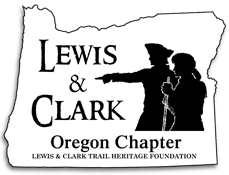The Corps
by the late Irving W. Anderson (1920-1999)
The party of 33 included 29 individuals who were active participants in the Corps’ organizational development, recruitment and training at its 1803-1804 winter staging area at Camp Dubois, Illinois Territory; its journey up the Missouri River; and its stay at Fort Mandan, the expedition’s 1804-1805 winter headquarters. Two members originally recruited for the Pacific bound party, Privates Moses Reed and John Newman, were dismissed before the explorers reached Fort Mandan. Reed was convicted for desertion, and Newman for “mutinous acts.” Stiff sentences, including “100 lashes on [Newman’s] bear back” were imposed through trials by court martial proceedings. Due to the remote, wilderness places of their crimes, both remained with the party over the Fort Mandan winter, doing hard labor. They were sent downriver aboard the keelboat in the spring of 1806.
Two French-Canadian fur traders, Jean Baptiste LePage and Toussaint Charbonneau, were enlisted at Fort Mandan to replace Newman and Reed. LePage held the rank of private, and Charbonneau, together with his Shoshone Indian wife, Sacagawea, who would be burdened with their infant boy, Jean Baptiste, were recruited as interpreters. The Fort Mandan-to-Fort Clatsop personnel were of white, black, and red racial origins, plus mixtures of the three. The oldest among the men was Charbonneau, who was 47 years old. Sacagawea was a teenager thought to be approximately 17. Jean Baptiste Charbonneau, whom Captain Clark affectionately nicknamed “Pomp” and “Pompy” for his “little dancing boy” antics, was only 55 days old when the explorers departed Fort Mandan on April 7, 1805, bound for the Pacific Ocean.
The following are biographical vignettes of each of the 33 permanent party members. All the men were hand-picked; the two officers for their leadership abilities, and their detachment for frontier, hunting, woodcutting, specialized craftmanship, and interpreting skills. Those who distinguished themselves during the mission for their more than routine contributions, or were unique members, are treated individually. A total of 12 who made no special mark are listed collectively, with their individual activities noted in appropriate journal entries.
Lewis, on January 15, 1807, in transmitting to the Secretary of War his roll of the men who accompanied him on his exploring mission “through the continent of North America,” gave praise and gratitude collectively to the members of the Corps of Discovery:
“With rispect to all those persons whose names are entered on this roll, I feel a peculiar pleasure in declaring, that the Ample support which they gave me under every difficulty; the manly firmness which they evinced on every necessary occasion; and the patience and fortitude with which they submited to, and bore, the fatigues and painful sufferings incident to my late tour to the Pacific Ocean, entitles them to my warmest approbation and thanks; nor will I suppress the expression of a hope, that the recollection of services thus faithfully performed will meet a just reward in an ample remuneration on the party of our Government.” – Meriwether Lewis, Captain 1st U.S. Regt. Infty.






